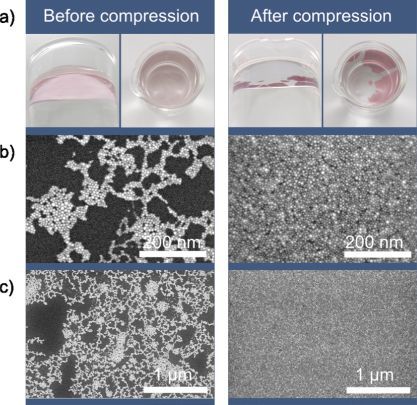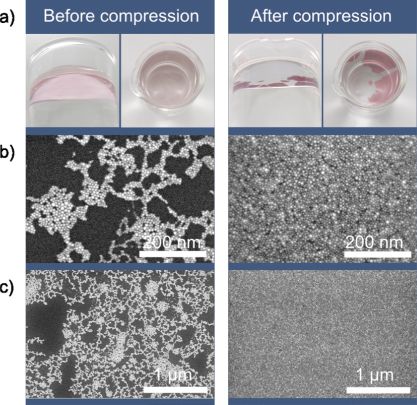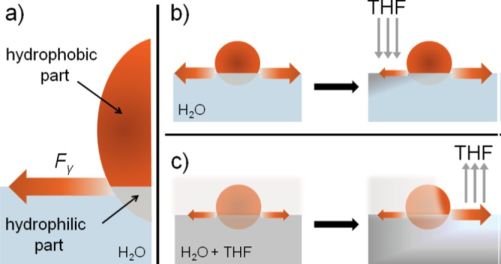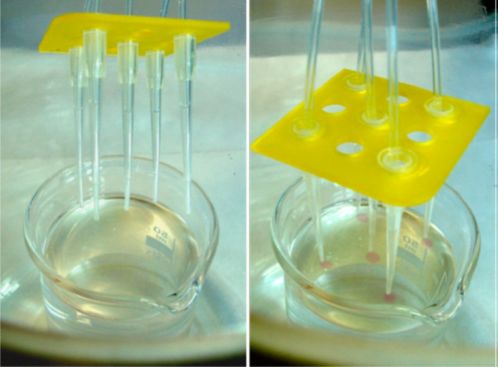Reference : ACS Nano 2013, 7, 8833-8839
Authors : Volodymyr Sashuk,* Katarzyna Winkler, Andrzej Zywocinski, Tomasz Wojciechowski, Ewa Gorecka, and Marcin Fiazkowski*
Authors : Volodymyr Sashuk,* Katarzyna Winkler, Andrzej Zywocinski, Tomasz Wojciechowski, Ewa Gorecka, and Marcin Fiazkowski*
Self-assembly is the most feasible way to build large and complex structures from single components, i.e. nanoparticles (NP’s). In most artificial systems, NP’s are organized into complex, ordered assemblies whose structures cannot be further modified or reconfigured, in a process known as static self-assembly. Contrarily, dynamic self-assembly of ordered structures in steady-state systems brought away from equilibrium can show adaptive behavior and can be reconfigured in response to external stimuli.
The system examined in this study composed of positively charged Au NP’s (diameter ~11 nm) dispersed at the air-water interface. The NP ligand shell consisted of a binary mixture of hydrophobic 1-undecanethiol (UDT) and hydrophilic 11- mercapto-N,N,N-trimethylundecane-1-aminium chloride/ bromide (TMA) (1st figure, a). Owing to their amphiphilic character as well as their electrostatic stabilization, the NP’s were readily spread at the air-water interface giving a light-pink uniform film.
The system could exhibit dynamic self-assembly due to the imposed gradient of surface tension in two different manners. In the DySA1 system (1st figure, b), a THF droplet placed on the water surface caused a rapid shrinking of the interfacial NP’s into a compact, rigid film. It has to be noted that the system reacted instantly when the surface tension gradient was created (stimulus ON) and relaxes slowly to its equilibrium when the gradient vanished (stimulus OFF). In the DySA2 approach (1st figure, c), the system was initially saturated with THF. When air flow was directed towards the interface, the NP’s instantly organized into a dense film at the area from which the air saturated with THF was blown out. When the air flow was stopped, the NP film disintegrated into a sparse monolayer within a few seconds.
SEM experiments on the interfacial NP structures obtained by the DySA1 method revealed that upon treatment with THF, the NP’s were compressed into a densely packed monolayer. The NP’s collected from the sparse films were also arranged in close-packed domains; however, these domains were small and were evenly distributed throughout the interface (2nd figure).

The mechanism responsible for the dynamic self-assembly of the NP’s at the fluid interface is based on ‘capillary traps’. When a surface tension gradient exists, the interfacial NP’s move in the direction of higher surface tension (3rd figure). In DySA1, such a gradient was created by the addition of organic solvent at the interface. The surface tension between the air and the THF-rich aqueous phase was lower than that between air and pure water. Upon equilibration of the surface tension, the NP’s were again scattered at the water surface. In DySA2, the gradient was due to the removal of THF from above the interface. In this case, the THF-rich air / THF-rich aqueous phase surface tension is lower than the THF-free air / THF-rich aqueous phase one.
The authors further exploited the dynamic nature of the DySA2 route to control the spatial distribution of NP assemblies on fluid interfaces. By employing five nozzles to simultaneously blow air on a THF-saturated interface, a pattern resembling a 5-pips die face was created on the water surface. Each visible red spot corresponded to a compressed NP monolayer. The pattern could be erased once the air supply was stopped (4th figure).
In conclusion, the researchers claim that the constructed dynamically self-assembling system could offer a simple and fast ‘chemical’ alternative for the Langmuir-Blodgett technique that could potentially be employed for the fabrication of large-area NP monolayer films.



